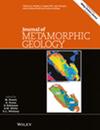Erzgebirge超高压石榴石的成因:玄武岩原岩经蛇纹岩辅助交代作用形成?
摘要
Erzgebirge超高压(UHP)石榴石橄榄岩包括稀少的石榴石-辉石岩层、石榴石结核,以及非常罕见的榴辉岩。与同一UHP单元中存在的片麻岩榴辉岩相比,以橄榄岩为主的榴辉岩显示出相同的亚碱性玄武岩块状岩石成分、矿物组合和峰值条件。与榴辉岩相比,石榴石具有相当多的Mg,适度增强的Ca和Fe,以及显著降低的Na、Ti、P、K和Si含量,而Al非常相似。此外,与榴辉岩相比,石榴石中的相容微量元素(Ni、Co、Cr、V)升高,大多数不相容元素(Zr、Hf、Y、Sr、Rb和稀土元素[REE])贫化。与其他大离子亲石元素(LILEs)相比,Pb(+121%)和Ba(+83%)强烈富集。石榴石的REE模式以轻、重REE贫化和中等REE峰为特征,表明交代作用,榴辉岩中没有这种特征。一个特殊的石榴石样品显示出与榴辉岩相似的REE分布。石榴石被解释为由与榴辉岩相同但交代蚀变的火成原岩形成。除Ba和Pb外,石榴石的化学特征最好通过寄主橄榄岩蛇纹石化引起的玄武岩原岩交代变化来解释。石榴石在化学性质上类似于玄武岩绿柱石/变质绿柱石。尽管绿柱石通常富含Ca,但也有与Erzgebirge石榴石成分相匹配的适度增强Ca的例子。有限的Ca交代作用归因于含水蚀变过程中橄榄岩中Ca的保存。这可以解释为不完全的蛇纹石化有利于原始斜辉石的亚稳生存。在这种情况下,大部分Ca保留在橄榄岩中,不可用于石榴石原岩的渗透和交代。斜辉石是石榴石-橄榄岩UHP组合的一部分,这一事实支持了这一不可避免的后果,如果在高压变质作用之前从原岩中去除了Ca,情况就不会如此。石榴石中相容元素的富集归因于蛇纹石化过程中橄榄岩-橄榄石(Ni,Co)和尖晶石(Cr,V)的分解。Ba和Pb的富集与其他LILE的行为形成对比,并归因于蛇纹石化橄榄岩的脱水(去萜化)。这需要两个独立的交代阶段:(1)玄武岩-石榴石前体的强烈化学蚀变,以及海底或初始俯冲期间橄榄岩的蛇纹石化;以及(2)在持续俯冲过程中,蛇纹岩的进变质作用和脱水作用,从而释放出与相关变质玄武岩反应的富含Pb–Ba的流体。最后,俯冲至>100 所有岩性的km和UHP变质作用导致形成石榴石、榴辉岩和石榴石辉石岩,由Erzgebirge中观察到的共面石榴石橄榄岩托管。

Erzgebirge ultrahigh-pressure (UHP) garnet peridotite includes scarce layers of garnet pyroxenite, nodules of garnetite and, very rarely, of eclogite. Peridotite-hosted eclogite shows the same subalkali-basaltic bulk rock composition, mineral assemblage and peak conditions as gneiss-hosted eclogite present in the same UHP unit. Garnetite has considerably more Mg, moderately enhanced Ca and Fe and significantly lower contents of Na, Ti, P, K and Si than eclogite, whereas Al is very similar. In addition, the compatible trace elements (Ni, Co, Cr, V) are elevated and most incompatible elements (Zr, Hf, Y, Sr, Rb and rare Earth elements [REE]) are depleted in garnetite relative to eclogite. In contrast to other large ion lithophile elements (LILEs), Pb (+121%) and Ba (+83%) are strongly enriched. The REE patterns of garnetite are characterized by depletion of light and heavy REE and a medium REE hump indicative of metasomatism, features being absent in eclogite. An exceptional garnetite sample shows an REE distribution similar to that of eclogite. Garnetite is interpreted to have formed from the same, but metasomatically altered, igneous protolith as eclogite. Except for Ba and Pb, the chemical signature of garnetite is explained best by metasomatic changes of its basaltic protolith caused by serpentinization of the host peridotite. Garnetite is chemically similar to basaltic rodingite/metarodingite. Although rodingite is commonly more enriched in Ca, there are also examples with moderately enhanced Ca matching the composition of Erzgebirge garnetite. Limited Ca metasomatism is attributed to the preservation of Ca in peridotite during hydrous alteration. This can be explained by incomplete serpentinization favouring metastable survival of the original clinopyroxene. In this case, most Ca is retained in peridotite and not available for infiltration and metasomatism of the garnetite protolith. This inescapable consequence is supported by the fact that clinopyroxene is part of the garnet peridotite UHP assemblage, which would not be the case if Ca had been removed from the protolith prior to high-pressure metamorphism. The enrichment of compatible elements in garnetite is attributed to decomposition of peridotitic olivine (Ni, Co) and spinel (Cr, V) during serpentinization. Enrichment of Ba and Pb contrasts the behaviour of other LILEs and is ascribed to dehydration of the serpentinized peridotite (deserpentinization). This requires two separate stages of metasomatism: (1) intense chemical alteration of the basaltic garnetite precursor, together with serpentinization of peridotite at the ocean floor or during incipient subduction; and (2) prograde metamorphism and dehydration of serpentinite during continued subduction, thereby releasing Pb–Ba-rich fluids that reacted with associated metabasalt. Finally, subduction to >100 km and UHP metamorphism of all lithologies led to formation of garnetite, eclogite and garnet pyroxenite hosted by co-facial garnet peridotite as observed in the Erzgebirge.

 求助内容:
求助内容: 应助结果提醒方式:
应助结果提醒方式:


